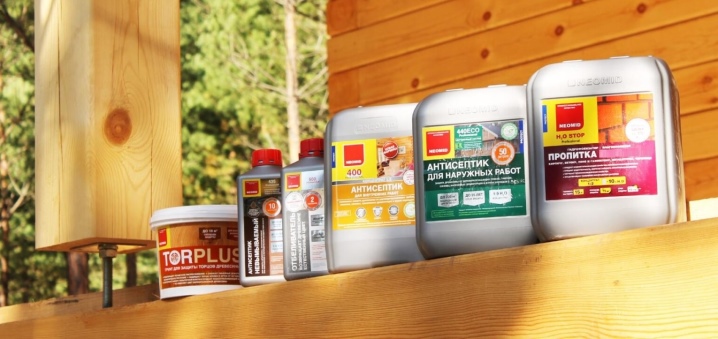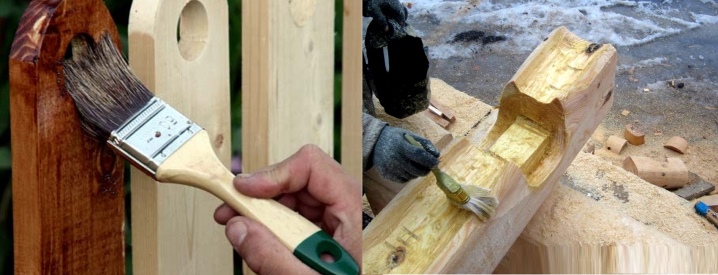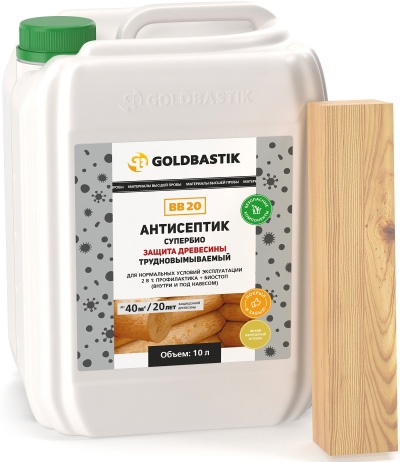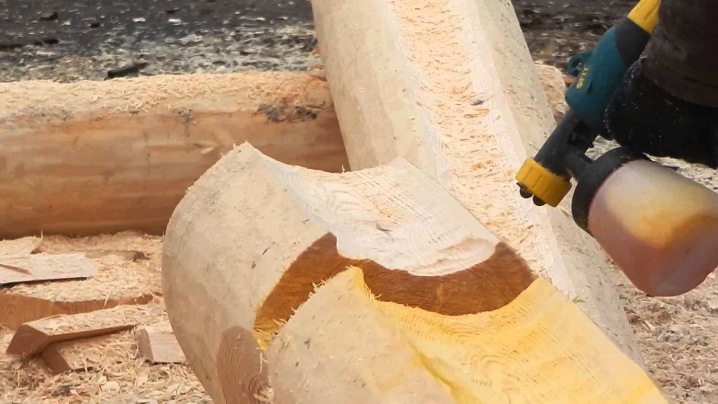How to make do-it-yourself wood preservatives?

Treatment of wooden structures with antiseptic drugs will extend the service life of buildings. A indelible antiseptic is a good choice for wooden structures. There are many options for such tools on sale that allow you to achieve a positive result. Considering that sometimes a large surface is treated with special substances, which is quite expensive, it is better to do the impregnation for wood yourself.

How to make from copper sulfate?
Wood is an excellent material used in construction. Such natural, environmentally friendly raw materials have many advantages. However, wood also has disadvantages. They are expressed in the presence of enemies in the form of insects, fungi, and mold. Wood is also afraid of fire and moisture. That is why the material needs special protection to repel pests and resist negative weather factors. In this case, we are talking about antiseptic impregnations.

Since ancient times, people have struggled with similar problems in different ways. Usually, for rooms with high humidity, certain types of trees were chosen that were most resistant to lesions: oak, alder, larch. Firing wood with an open flame was popular. In addition, special impregnating compositions were used, which are the prototypes of today's antiseptics. The surfaces were treated with birch tar, linseed and sunflower oil, resin of coniferous trees.
Impregnations for wooden surfaces are special moisture-repelling mixtures that protect and protect the material from pests.
Experts recommend impregnating the surface in advance, before construction work. But even after the completion of the repair, the effect of applying the product will be positive.

Using wood preservatives helps:
- protect surfaces from UV rays, as well as rain and snow (outdoor use);
- scare off bark beetles and other insects;
- to reduce damage to the material during transportation or being for a long time in adverse weather conditions in the open air;
- protect against mold and mildew in damp and humid places.

According to their composition, wood antiseptics can be divided into certain groups, which differ in basis.
- Water-based products. They are used to protect the surface of furniture and other wooden objects indoors, where they are usually not exposed to high humidity.

- Preparations with an oil base. It is customary to use them for processing materials outside the premises, that is, on the street. Oil formulations are usually not used in living rooms due to the pungent odor.

- Organosoluble. The main component of such mixtures is petroleum products. They are used both inside and outside living quarters. After their application, a dense moisture-proof film remains.

- Compositions on wax.

- Combined drugs.

The use of antiseptics helps to create a thin layer that prevents oxygen and moisture from entering, providing an anaerobic environment that suppresses pests.
Antiseptic agents that do not have a pungent odor are popular. The coating requires the application of 2-3 coats of the preparation. The antiseptic should not be applied to a damp surface, as the product will not be able to absorb well.Such funds can be toxic, so its choice should be approached responsibly.

You can prepare a composition with an outer coating on your own at home. The addition of paint or varnish will provide decorativeness to wood products.
The most popular are funds that have a water-salt base, because they are absolutely safe for people. The solution can have any concentration and depends on the area of their application.
When making mixtures, prepare suitable containers and mixing paddles. Typically, liquid solutions are applied with spray guns, thick formulations are applied with rollers, sponges or brushes. Ventilation is a prerequisite for carrying out such work in the premises.

One of the popular products used for wood processing is copper sulfate. It can be applied in different ways, which have certain features, as well as differences.

The least time consuming method is surface application. Usually it is used already when wood is damaged by fungus or rot. The term of protection in this case will not be long. If the material is fresh or poorly dried, then the antiseptic will be washed out even faster.
For surface application:
- take 10 grams of vitriol and sift it through a sieve;
- diluted in 1 liter of water;
- moisten a brush or sponge in the resulting solution, you can also use a spray;
- apply the mixture to the surface to be treated.

This treatment allows you to protect the layer of wood up to 2 mm. When deep cracks appear after the procedure, insects can settle in them, and a fungus can appear.
To protect the logs that will be buried in the ground, use treatment, keeping them in a 20% solution of the agent. The whole log or only part of it is immersed in the solution for 48 hours, then dried naturally for a month.
The sawn logs are processed by internal impregnation. For this, copper sulfate is mixed with tree sap. Considering that the movement of the juice lasts only a couple of days, it is advisable to do this work as early as possible.

To prepare a more powerful antiseptic from copper sulfate, you will need the following components:
- copper sulfate - 1 kg;
- sodium dichromate - 1 kg;
- water - 18 l;
- table vinegar 9% - 100 ml.

You can get the composition by mixing these components. To improve their solubility, it is advisable to heat the water to 50 degrees. The resulting mass is thoroughly mixed and used for processing wooden surfaces.
This product is toxic, therefore, when working with it, you must adhere to safety rules.
When applying some preparations, it is necessary to provide yourself with protective equipment in the form of a suit, glasses, rubber gloves and a respirator. It is advisable to choose harmless and affordable components, having learned in advance how toxic they are.

Do not store the copper sulfate solution. Also, metal containers are not used to dilute the composition, since the agent corrodes the metal. It is not recommended to handle wood products with metal elements, nails or bolts with it.
Iodine antiseptic recipe
For processing wooden structures, a homemade iodine-based preparation is suitable. Its composition is very simple. You need to take a container and pour 4 liters of water into it. Then add 2 bottles of pharmaceutical iodine there. Stir the mixture well. Now the tool can be used in work.

A composition with an iodine base is suitable when applied to visible parts of productssince it does not stain the surface.

In addition to iodine, other products from the home pharmacy are also used for wood processing. In a similar way, you can make a solution of greenery and fucorcin.

Other cooking options
There are different types of wood preservatives. Oil-based products give a good result. It can be linseed or hemp oil. Such impregnation will not only protect the wood from damage and rot, insect attacks, but also act as a decorative coating. TAs a result, linseed oil will give the products a beautiful golden color. To fix it in flax oil, it is better to add extracts of burdock, elecampane, angelica or galangal.

After such processing, waxing can be done to give an aesthetic appearance to the products. For work you will need:
- 100 g wax;
- 25 g of rosin;
- 50 g turpentine.
Turpentine can be replaced with linseed oil if the product is prepared for home use.

To prepare the mixture, you need to melt the wax in a water bath, add the rosin and mix, pour oil into the container. After boiling, the composition is poured into a previously prepared vessel. The resulting solidifying mass is treated with a rag until shine appears.
Do-it-yourself antiseptics will help protect wooden surfaces from damage and disease.
For more details on how to make do-it-yourself wood preservatives, see the next video.













The comment was sent successfully.